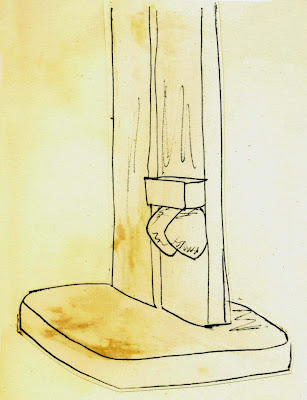Όταν
δια της πίστεως και της καλής θελήσεως,
αλλά
και από επιτακτικήν, αδήριτον
ανάγκην δημιουργηθούν
αι προϋποθέσεις
και εκτελεσθούν όχι οικοδομικά, ή
ορθολογιστικά, μα διαφορετικά τελείως
έργα, εις
την καρδιά του μέλλοντος,
εις την καρδιά των υψηλών
οροπεδίων
και προ παντός μέσα στην καρδιά του κάθε
ανθρώπου, θα υπάρξη τότε μόνον η Νέα
Πόλις και
θα ονομασθή πρωτεύουσα της
ηνωμένης, της αρραγούς
και αδιαιρέτου
Οικουμένης.
Άγνωστον αν η παλαιά,
που εκτείνεται προ του
ωκεανού στα
πόδια του κατακορύφου βράχου που μοιάζει
με το Τζέμπελ-αλ-Ταρέκ, άγνωστον αν θα
εγκαταλειφθή,
ή αν θα υφίσταται καν
στα χρόνια εκείνα, ή αν, απέραντη
και
κενή, θα διατηρηθή ως δείγμα μιάς
ελεεινής, μιας
αποφράδος εποχής, ή ως
θλιβερόν μουσείον διδακτικόν,
πλήρες
παραδειγμάτων πρό αποφυγήν. Εκείνο που
είναι
βέβαιον είναι ότι η Νέα Πόλις
θα οικοδομηθή, ή μάλλον
θα δημιουργηθή,
και θα είναι η πρωτεύουσα του
Νέου
Κόσμου, εις την καρδιά του μέλλοντος
και των
ανθρώπων, μετά χρόνια πολλά,
οδυνηρά, βλακώδη και
ανιαρά, ίσως μετά
μιαν άλωσιν οριστικήν, μετά την
μάχην
την τρομακτικήν του επερχομένου
Αρμαγεδδώνος.
Δεν θα εξετάσω τας
λεπτομερείας.....
....................
Αυτό
που με ενδιαφέρει απολύτως-και θα έπρεπε
να
ενδιαφέρη όλους-είναι ότι η Νέα
Πόλις θα
ολοκληρωθή, θα γίνη. Όχι
βεβαίως απο αρχιτέκτονας
και πολεοδόμους
οιηματίας, που ασφαλώς πιστεύουν
οι
καημένοι, ότι μπορούν αυτοί τους βίους
των
ανθρώπων εκ των προτέρων να
ρυθμίζουν και το μέλλον
της ανθρωπότητος,
με χάρακες, με υποδεκάμετρα, γωνίες
και
Τ, μέσα στα σχέδια της φιλαυτίας των,
ναρκισσευόμενοι (μαρξιστικά, φασιστικά
ή αστικά),πνίγοντες
και πνιγόμενοι να
κανονίζουν.
Όχι, δεν θα κτισθή
η Νέα Πόλις έτσι, μα θα κτισθή από
όλους
τους ανθρώπους, όταν οι άνθρωποι. έχοντας
εξαντλήσει
τας αρνήσεις, και τας καλάς
και τας κακάς, βλέποντες το
αστράπτον
φως της αντισοφιστείας-τουτέστι το φως
της άνευ
δογμάτων, άνευ ενδυμάτων
Αληθείας-παύσουν στα αίματα και
στα
βαριά αμαρτήματα χέρια και πόδια να
βυθίζουν, και
αφήσουν μέσα στις ψυχές
των, με οίστρον καταφάσεως, όλα
τα
δένδρα της Εδέμ, με πλήρεις καρπούς και
δίχως
όφεις-μα τον Θεό, ή τους
Θεούς-τελείως ελεύθερα να ανθίσουν.
Ναι, ναι (αμήν, αμήν λέγω υμίν),σας λέγω
την αλήθειαν.
Η Νέα Πόλις θα κτισθή
και δεν θα είναι χθαμαλή σε
βαλτοτόπια.
Θα οικοδομηθή στα υψίπεδα της Οικουμένης,
μα δεν θα ονομασθή Μπραζίλια, Σιών,
Μόσχα, ή Νέα Υόρκη,
αλλά θα ονομασθή η
πόλις αυτή Ο κ τ ά ν α .
Και τώρα ο
καθείς θα διερωτηθή ευλόγως: Μα τι θα
πή Οκτάνα;
.............................
Και τώρα (αμήν, αμήν) λέγω υμίν :
Οκτάνα, φίλοι μου, θα πή μεταίχμιον της
Γης και του
Ουρανού, όπου το ένα στο
άλλο επεκτεινόμενο ένα τα δύο κάνει.
Οκτάνα θα πή πύρ, κίνησις, ενέργεια,
λόγος σπέρμα.
Οκτάνα θα πη έρως
ελεύθερος με όλας τας ηδονάς του.
Οκτάνα θα πή ανά πάσαν στιγμήν ποίησις,
όμως όχι ως μέσον
εκφράσεως μόνον, μα
ακόμη ως λειτουργία του
πνεύματος
διηνεκής.
Οκτάνα θα πή η εντελέχεια
εκείνη, που αυτό που είναι
αδύνατον
να γίνη αμέσως το κάνει εν τέλει δυνατόν,
ακόμη και
την χίμαιραν, ακόμη και την
ουτοπίαν, ίσως μια μέρα και
την αθανασίαν
του σώματος και όχι μονάχα της ψυχής.
Οκτάνα θα πή το "εγώ" "εσύ"
να γίνεται (και αντιστρόφως
το "εσύ"
"εγώ" ) εις μίαν εκτόξευσιν ιμερικήν,
εις μίαν
έξοδον λυτρωτικήν, εις μίαν
ένωσιν θεοτικήν, εις μίαν
μέθεξιν
υπέρτατην, που ίσως αυτή να αποτελή την
θείαν Χάριν,
το θαύμα του εντός και
εκτός εαυτού, κάθε φοράν που
εν εκστάσει
συντελείται.
Οκτάνα θα πή πάση
θυσία διατήρησις της παιδικής ψυχής
εις όλα τα στάδια της ωριμότητος, εις
όλας τας
εποχάς του βίου.................
Οκτάνα θα πή εν πλήρει αθωότητι Αδάμ,
εν πλήρει
βεβαιότητι Αδάμ-συν-Εύα.
.................................
Οκτάνα θα
πή απόλυτος ενότης πνεύματος και ύλης.
Οκτάνα θα πή παντού και πάντα εν
ηδονή ζωή.
Οκτάνα θα πή δικαιοσύνη.
Οκτάνα θα πή αγάπη.
Οκτάνα
θα πή παντού και πάντα καλωσύνη.
Οκτάνα θα πή η αγαλλίασις εκείνη που
φέρνει στα χείλη
την ψυχή και εις τα
όργανα τα κατάλληλα με ορμήν το σπέρμα.
..................................
Οκτάνα θα
πή ό,τι στους ουρανούς και επί της γης
ηκούετο,
κάθε φοράν που ως μέγας
μαντατοφόρος, με έντασιν
υπερκοσμίου
τηλεβόα, ο Άγγελος Κυρίου εβόα.
...............................
Aνδρέας
Εμπειρίκος, Γλυφάδα, 20. 8. 1965











